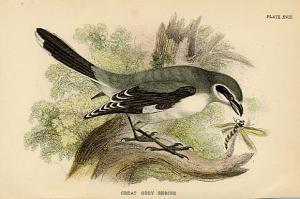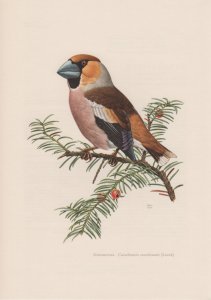It was an afternoon I will always remember; for in a birder’s life there are days when you see nowt but a woodpigeon, and then there are days – days few and far between – when you see birds that make your eyeballs fall out and explode. The 18th January was one of those days.
John and I were continuing to shorten our ‘hit-list’ of birds we needed (not wanted – needed) to see in Britain and with the optimism of youth I had decided that we should try to see two new species on this trip; a Great Grey Shrike that was wintering on Iping Common and Hawfinches at a well-known site not far from there. Our first stop at the Sussex Wildlife Trust reserve of Iping and Steadham commons is located near Midhurst, which is in the centre of the South Downs National Park and within an area called the ‘Greensand ridge’. Beneath the soil of West Sussex there is a large patch of bedrock called ‘greensand’ that begins as a thin line of hills directly in front of the North Downs, this expands westwards into a complicated large blob that underlies the larger portion of West Sussex and part of Hampshire. This gritty, acidic stone greatly affects the morphology and wildlife of the region – resulting in a beautiful undulating land of wooded hills, secluded combs, scattered patches of red-purple heath and gorgeous views south to the dark, mysterious-looking, tree coated South Downs.
As we walked along the sandy path and scanned every birch tree, the three degrees of heat that the frosty sun was leaking out made little impact to our numb fingers. The ground was sodden and we regularly had to tiptoe around puddles as we made our way across the heath; there was no sign of a single bird – let alone a shrike – it seemed as though they had all been frozen to the branches. Our eyes were hard at work checking every tree and shrub for any sign of our target bird, as well as keeping a sly watch on the birders a few hundred metres away in case they saw it first. A tad frustratingly – they did, but there is no ill will amongst our kin and they kindly pointed it out for us once we had legged-it in their direction after an excited wave from one of them. It was atop a birch tree on a nearby ridge, not exactly close but near enough for it to be unmistakable – and what a bird! The size of a blackbird and armed with a thick, sharp beak this is an impressive creature – sure to cause any nearby blue tits some worry – its plumage is mostly a soft grey broken up with a solid black mask and wings and a few white patches, its tail is long and swaying constantly and the birds head looks twice the size it should be. Both the Great-Grey and Red-backed shrikes were once known as ‘Butcher-birds’ because they feed on meat and store their catches by piercing them on thorn bushes, akin to big cats hauling prey up into trees.
We then took a pleasant country road to Westdean woods, and as we drove along the back of the Downs we saw three huge Red Kites; an increasingly common sight in Sussex, but one that I am still not used to – and awed by every time. The woods in question are owned by the Sussex Wildlife Trust and sit secluded on the long south slope of the Downs, access is prohibited but fortunately for birders there is a bridleway that passes through it. The path starts as a muddy ditch enclosed in a tunnel of trees; there is a view westwards over fields and valleys, walking up this hidden by-way I felt far from civilisation and very close to nature; I had a wondrous feeling of peace and contentment. As we approached the main wood a mixed flock of tits and other species passed by us through the hedgerow, apparently oblivious of our presence Marsh Tits, Great Tits and Blue Tits flitted by – accompanied by a tiny Treecreeper. Further up there was an area of coppice studded with mature Oaks, it looked like great habitat for wildlife and as if to underline this a bird alighted upon the top of an Oak, I focused my bins on it and immediately gasped: “It’s a Hawfinch!” These big finches are easily in the category of birds-you-don’t-believe-exist-until-you-see-one-yourself, highly elusive and unexplainably rare; they hardly call or sing and confine themselves to the tops of trees. Unless you are annoyingly lucky enough to see one away from a known site, your only decent chance of seeing this cryptic species is by visiting such a place as Westdean woods – but this does not detract from the exciting experience.
Our day did not end there though, for in that same coppiced area we saw three lovely Bullfinches, Nuthatches, Coal tits, many very confiding Goldcrests and some Long-tailed tits (bringing our tally to five Tit species – no sniggering). I could scarce believe it however when I identified a small bird that I’d noticed fluttering around a nearby Oak; for it was a beautiful Firecrest. I have only seen one of these before (someone had to point it out) and these diminutive birds are scarce, so John was understandably sceptical when I spluttered out what I was looking at between gulps of air and rushes of adrenaline. Much to our delight it hopped so close we hardly needed binoculars and could fully appreciate its striking plumage – like its cousin the Goldcrest it has a fiery stripe atop its head, but it differs in having a pattern of black-white-black on either side and a shoulder-patch of orangey-gold. We both felt quite blessed by the fantastic birds and rural scenery we had encountered that day as we drove back home; I had not expected to see both target species let alone an A-list supporting cast! Needless to say we celebrated by gorging on chocolate caramel biscuits hurriedly bought in a service station – before dinner too – naughty.




November 27, 2016 at 5:08 pm
That print at the head of this post looks like an old one by Bob Greenhalf, who lives in Rye
LikeLike